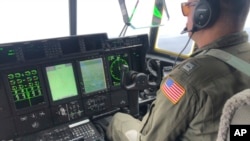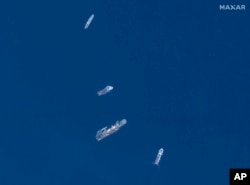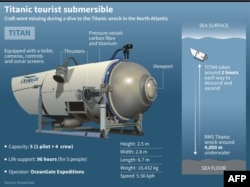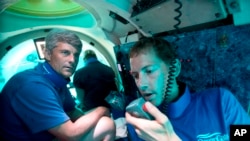The U.S. Coast Guard said Thursday that a missing submersible had imploded near the wreckage of the Titanic, killing all five people on board.
Coast Guard officials said during a news conference that they'd notified the families of the crew of the Titan, which has been missing for several days. Debris found during the search “is consistent with a catastrophic implosion of the vessel,” said Rear Admiral John Mauger of the First Coast Guard District.
“The outpouring of support in this highly complex search operation has been greatly appreciated. Our most heartfelt condolences go out to the friends and loved ones of the crew,” Mauger said.
OceanGate Expeditions said in a statement that all five people on board, including company CEO Stockton Rush, were believed to be dead. Rush, Shahzada Dawood and his son Suleman Dawood, Hamish Harding and Paul-Henri Nargeolet “have sadly been lost,” OceanGate said in a statement.
OceanGate did not provide details when it announced the “loss of life” in a statement or how officials knew the crew members had perished. The Titan's 96-hour oxygen supply likely ended early Thursday.
OceanGate has been chronicling the Titanic’s decay and the underwater ecosystem around it via yearly voyages since 2021.
The Titan was estimated to have about a four-day supply of breathable air when it launched Sunday morning in the North Atlantic, but experts emphasized that was an imprecise approximation and could be extended if passengers had taken measures to conserve breathable air.
The Titan was reported overdue Sunday afternoon about 700 kilometers south of St. John’s, Newfoundland, as it was on its way to where the iconic ocean liner sank more than a century ago.
Rescuers rushed ships, planes and other equipment to the site of the disappearance.
The U.S. Navy said in a statement Wednesday that it was sending a specialized salvage system that’s capable of hoisting “large, bulky and heavy undersea objects such as aircraft or small vessels."
The Titan weighs 9,000 kilograms. The U.S. Navy’s Flyaway Deep Ocean Salvage System is designed to lift up to 27,200 kilograms, the Navy said on its website.
On Thursday, the U.S. Coast Guard said an undersea robot sent by a Canadian ship had reached the sea floor, while a French research institute said a deep-diving robot with cameras, lights and arms also joined the operation.
Dr. Rob Larter, a marine geophysicist with the British Antarctic Survey, emphasized the difficulty of finding something the size of the submersible, which is about 6.5 meters long and nearly 3 meters high.
Authorities were hoping underwater sounds would help narrow their search. Coast Guard officials said underwater noises were detected in the search area Tuesday and Wednesday.
Retired Navy Captain Carl Hartsfield, now the director of the Woods Hole Oceanographic Systems Laboratory, said the sounds detected that were described as “banging noises,” but he warned that search crews “have to put the whole picture together in context and they have to eliminate potential manmade sources other than the Titan.”
The report of sounds was encouraging to some experts because submarine crews unable to communicate with the surface are taught to bang on their submersible’s hull to be detected by sonar.
But Jamie Pringle, an expert in Forensic Geosciences at Keele University, in England, said even if the noises were from the submersible, "the lack of oxygen is key now; even if they find it, they still need to get to the surface and unbolt it."
By Thursday morning, hope was running out that anyone on board the vessel would be found alive.
At least 46 people successfully traveled on OceanGate’s submersible to the Titanic wreck site in 2021 and 2022, according to letters the company filed with a U.S. district court in Norfolk, Virginia, that oversees matters involving the Titanic shipwreck.
But newly uncovered allegations suggest there had been significant warnings made about vessel safety during the submersible’s development.
One of the company’s first customers characterized a dive he made to the site two years ago as a “kamikaze operation.”
“Imagine a metal tube a few meters long with a sheet of metal for a floor. You can’t stand. You can’t kneel. Everyone is sitting close to or on top of each other,” said Arthur Loibl, a retired businessman and adventurer from Germany. “You can’t be claustrophobic.”
During the 2-1/2-hour descent and ascent, the lights were turned off to conserve energy, he said, with the only illumination coming from a fluorescent glow stick.
The dive was repeatedly delayed to fix a problem with the battery and the balancing weights. In total, the voyage took 10 1/2 hours.
The submersible had seven backup systems to return to the surface, including sandbags and lead pipes that drop off and an inflatable balloon.
Nick Rotker, who leads underwater research for the nonprofit research and development company MITRE, said the difficulty in searching for the Titan has underscored the U.S.'s need for more underwater robots and remotely operated underwater vehicles.










